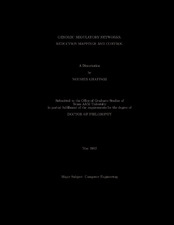| dc.description.abstract | All high-level living organisms are made of small cell units, containing DNA,
RNA, genes, proteins etc. Genes are important components of the cells and it is
necessary to understand the inter-gene relations, in order to comprehend, predict and
ultimately intervene in the cells’ dynamics. Genetic regulatory networks (GRN) represent
the gene interactions that dictate the cell behavior. Translational genomics
aims to mathematically model GRNs and one of the main goals is to alter the networks’
behavior away from undesirable phenotypes such as cancer.
The mathematical framework that has been often used for modeling GRNs is the
probabilistic Boolean network (PBN), which is a collection of constituent Boolean
networks with perturbation, BNp. This dissertation uses BNps, to model gene regulatory
networks with an intent of designing stationary control policies (CP) for the
networks to shift their dynamics toward more desirable states. Markov Chains (MC)
are used to represent the PBNs and stochastic control has been employed to find
stationary control policies to affect steady-state distribution of the MC. However,
as the number of genes increases, it becomes computationally burdensome, or even
infeasible, to derive optimal or greedy intervention policies.
This dissertation considers the problem of modeling and intervening in large GRNs.
To overcome the computational challenges associated with large networks, two approaches
are proposed: first, a reduction mapping that deletes genes from the network;
and second, a greedy control policy that can be directly designed on large networks.
Simulation results show that these methods achieve the goal of controlling large networks
by shifting the steady-state distribution of the networks toward more desirable
states.
Furthermore, a new inference method is used to derive a large 17-gene Boolean network
from microarray experiments on gastrointestinal cancer samples. The new algorithm
has similarities to a previously developed well-known inference method, which
uses seed genes to grow subnetworks, out of a large network; however, it has major
differences with that algorithm. Most importantly, the objective of the new algorithm
is to infer a network from a seed gene with an intention to derive the Gene Activity
Profile toward more desirable phenotypes. The newly introduced reduction mappings
approach is used to delete genes from the 17-gene GRN and when the network is
small enough, an intervention policy is designed for the reduced network and induced
back to the original network. In another experiment, the greedy control policy approach
is used to directly design an intervention policy on the large 17-gene network
to beneficially change the long-run behavior of the network.
Finally, a novel algorithm is developed for selecting only non-isomorphic BNs, while
generating synthetic networks, using a method that generates synthetic BNs, with a
prescribed set of attractors. The goal of the new method described in this dissertation
is to discard isomorphic networks. | en |


